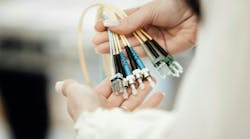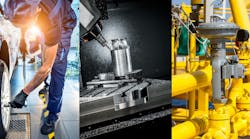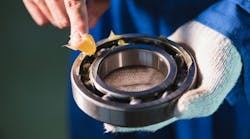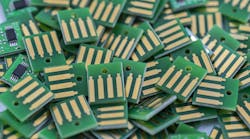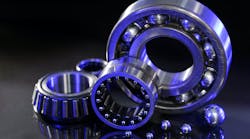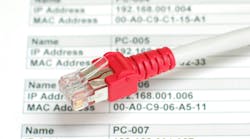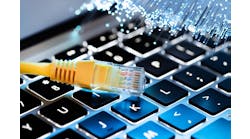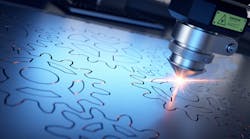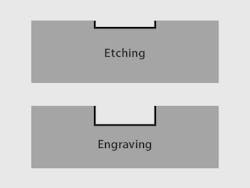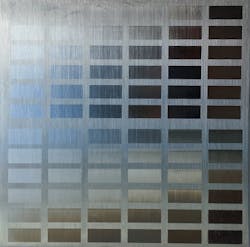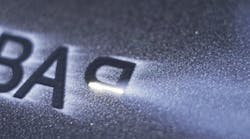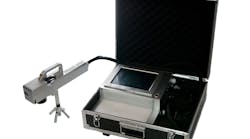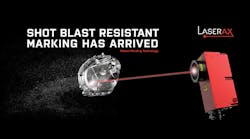When you think of lasers, what pops into your head? A scanner at the grocery store? A boobie trap in a James Bond movie? What about an industrial laser that marks metal, plastic, glass, paper, and rubber in seconds? That’s right, the magic of lasers doesn’t just exist in movies!
A laser, which is an acronym for Light Amplified by Stimulated Emission of Radiation, has been a widely used manufacturing marking tool since the 1970s. Lasers outperform competitors like chemical etching, ink printing, and shot blasting because of their speed, environmentally friendly marking, and precision.
But why? What makes lasers so beneficial, and what does laser marking even mean?
Types of Lasers in Manufacturing
Lasers are generated inside of a laser marking machine. Each laser marking machine is categorized by the type of resonating medium they have: solid, liquid or gas. A resonating medium is what boosts the energy into a laser light.
The most popular types of laser marking machines are CO2, fiber, and UV.
A fiber laser—a solid-state laser—uses a fiber resonator and wavelength of 1,090 nm. These lasers are known for high speed, power, and deep engraving. These lasers mark mostly on metals.
CO2 lasers, which are gas lasers, use plasma and CO2 as resonators and have the longest wavelength of all. The 10,600 nm wavelength has the most heat transfer, so they excel at shallow engraving glass, wood, paper, and synthetic rubber but not metal.
UV lasers, which are solid state, generate UV laser light by passing a laser through two crystals. The crystals shorten the wavelength of the laser light to the UV spectrum, which is absorbed at a much higher rate than the fiber or CO2 lasers. This makes it the best laser for heat-sensitive and heat-resistant materials.
What Is Laser Marking?
When we say “laser marking,” we're referring to the general term that covers categories like etching, engraving, and annealing. Laser marking methods for manufacturers are used for traceability, texturing, logos, and biocompatibility. Adding these marks is no-contact and uses processes like absorption, reflection, and sublimation.
Types of Laser Marking
Etching, engraving, and annealing are the three common laser marking techniques; let’s explore the differences.
Laser Etching
Laser etching works by shooting a beam onto a metal and electrifying it. The electrification results in the metal partially absorbing and partially reflecting the energy. The absorption makes the target area malleable, and it then expands and changes in color and texture. When the metal cools, it leaves behind a mark, often white, since light now reflects off of the marked area differently than the rest of the material. Fiber lasers are commonly used for laser etching.
Laser Engraving
Contrary to a similar name, laser engraving is different from etching. Laser engraving produces significantly more depth than laser etching does.
Laser engraving happens when a high-powered laser shoots its beam onto the material and conducts a process called sublimation. Sublimation is when a solid moves to the gas state and skips over the liquid state. Sublimation causes the material to evaporate and leave behind a mark instead of becoming malleable. Fiber lasers, UV lasers, and CO2 lasers are engraved on different materials like rubber, metal, glass, plastic, and paper.
Black Annealing
Annealing is different from engraving and etching because it doesn’t add any type of texture to the surface. Instead, annealing uses a process called carbon migration. Carbon migration is when a defocused laser beam hits the surface and activates the carbon content of a material. The carbon then migrates to the top and leaves behind a dark black mark. Since the laser is activating carbon contents, this process only works with metals that have carbon makeup.
Industries Using Laser Marking Right Now
We’ve discussed all the materials and processes that go along with laser marking, but who is using these processes?
Laser marking methods are used in virtually every industry, but they shine through in medical device, aerospace, automotive, and semiconductor industries. The efficiency, precision, and permanency are unbeatable.
Medical Devices
Biocompatibility, which is making an implant compatible with the human body, is added to devices and implants by texturing. Before laser technology, manufacturers were using shot blasting and chemical etching to make these textures. Interchanging shot blasting and chemical etching with laser etching is greener because it uses less waste and consumables, and it’s faster because the texturing happens in seconds.
The Federal Drug Administration (FDA) requires all medical devices, besides over-the-counter devices, to have a Unique Device Identifier (UDI). UDIs are 2D codes that store vital traceability information. They prevent counterfeits and ensure quality assurance. Laser annealing UDIs are popular because of the permanency, speed, and precise abilities of a laser machine to mark odd-shaped devices.
Aerospace
The aerospace industry frequents laser annealing and engraving for traceability purposes. Like the medical device industry, these marking methods thrive because of their speed and precision. Black annealing is particularly popular because it’s so high contrast that it can be seen from far away.
The aerospace industry also uses laser etching for texturing, but instead of biocompatibility, this texturing improves adhesion. NASA found that laser etching is an adhesion method that is as good if not better than Pasa-Jell (the standard method). Using laser texturing instead of chemical adhesion is faster and uses less waste.
Automotive
The automotive industry also benefits from laser marking because of its traceability and flexibility. The automotive industry produces parts of shapes, sizes, and materials that make up one whole component. For example, a CO2 laser engraves glass windows and rubber wiper blades, whereas fiber lasers engrave metal components like pistons, engine blocks, crankshafts, rotor/stators, etc. The versatility of laser marking makes the manufacturing process more cost-effective.
Semiconductor
Semiconductors are critical components of electronic devices like phones, electric vehicles, and computers. However, they are fragile and sometimes even smaller than a fingertip. The semiconductor industry has found solace in UV and fiber laser marking. Since laser marking is no-contact and can mark at the nano level, it is perfect for 2D traceability codes.
What Does It Mean To Own a Laser?
On a baseline, adding a laser to your manufacturing process will speed it up and guarantee permanent marks that fit your industry requirements. But even more than that, using a laser is a look at an evolving manufacturing future.
Now that the manufacturing industry is scattered after the pandemic with an influx of unskilled workers, loss of skilled workers, and ever-changing supply chain issues, the choice is to be proactive or reactive.
Laser marking methods for manufacturers are better than shot blasting, ink printing, and chemical etching because they’re also completely automated. Most laser machines follow computer numerical control (CNC) that requires hardly any technician work besides initial programming. Even with all the uncertainty, you can count on a laser to keep up.
Dave Reichlin is KEYENCE America's National Product Director for laser marking and processing. He has been consulting, innovating, and driving advances in the laser marking world for over 12 years and is a foremost expert on the technology and its applications in the manufacturing space.
